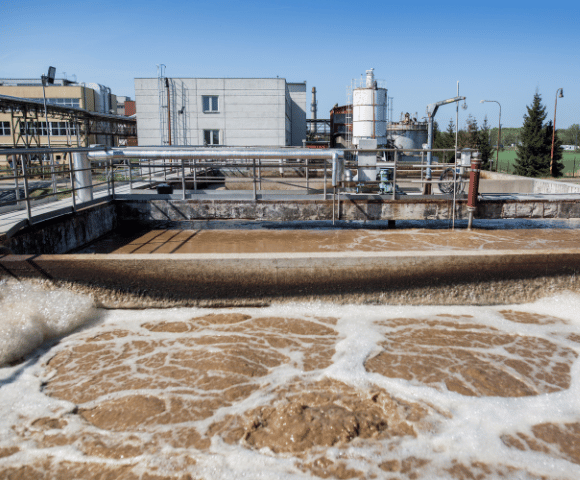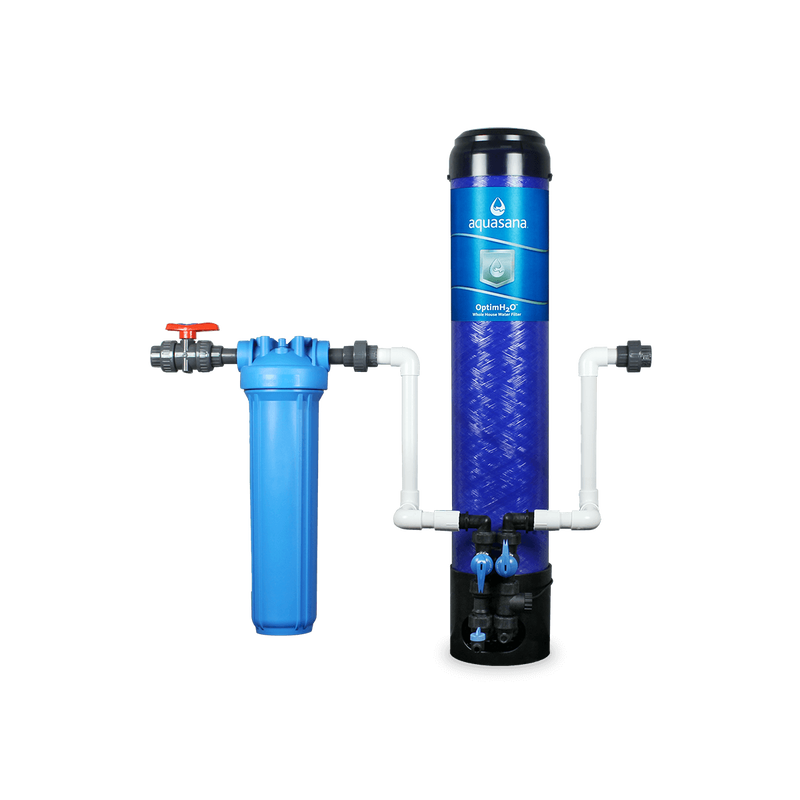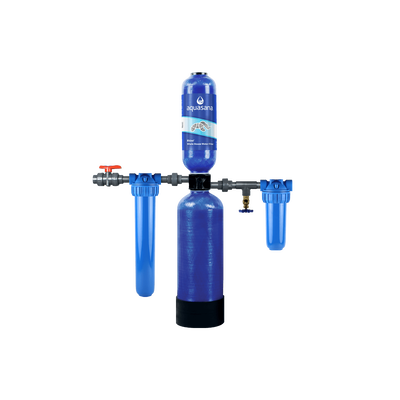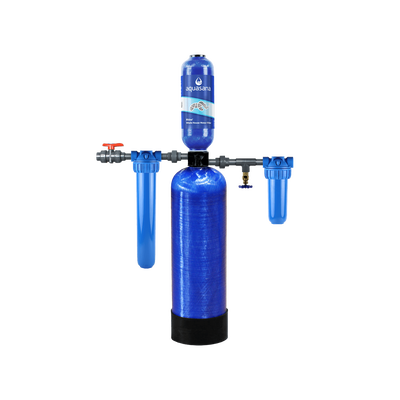This transition has been happening as far back as the 1930s. But just how popular are chloramines? In 2016, the Environmental Protection Agency (EPA) reported that one in five Americans (68 million, to be exact) are now drinking chloramine-treated water. They are primarily used in large cities as opposed to suburbs or small municipalities.
The most glaring question that comes to mind when reading that statistic is this: is a switch from chlorine to chloramine a cause for concern, celebration, or a shrug? Unfortunately, the answer is, it depends.
Chlorine vs. chloramines in drinking water
Drinking water is pulled from several sources including rivers, lakes, and wells. It’s then treated with chemicals to rid it of toxins and sent to a tap near you. The treatment process is incredibly important. In addition to standardizing water quality, chlorine and chloramine rid your drinking supply of waterborne diseases like cholera and typhoid.
Depending on where the water source is located, water can travel a long way to your sink. Cities work to ensure that when water reaches you, it’s free of contaminants or bacteria that may grow as water travels through pipes underground.
Chlorine has long been the primary disinfectant for water. While it is successful in ridding water of contaminants and bacteria, there are two primary drawbacks:
It doesn’t perform well in mixed company. A high percentage of dirt or germs in the original water source will react with chlorine to produce chemicals called disinfection by-products. Some of these by-products, specifically trihalomethanes (THMs), were found to be carcinogenic after a lifetime of exposure.
There’s no staying power. As previously mentioned, water sometimes travels long distances through the pipes. Chlorine disinfects the water effectively but does not remain in the water for a long period of time; chlorine wears off, giving bacteria and other chemicals an opportunity to reemerge.
These downsides aren’t enough to force all municipalities to move away from chlorine altogether, but in 1979 the EPA began regulating the level of disinfection byproducts in drinking water. In the case of the San Francisco Public Utilities Commission, their analysis found that continued use of chlorine would require significant capital investments to rid water of disinfection byproducts. Money talks, and in this case, money told San Francisco it may be worthwhile to try a cheaper alternative.
Enter chloramine, a solution that is 5–parts chlorine and 1-part ammonia. Unlike chlorine, chloramine produces significantly lower levels of disinfectant byproduct and remains in the water for a longer period, warding off toxins found in water throughout water’s journey to the tap.
Chlorine & chloramines: in the news
Even though chloramine provides certain benefits to the water treatment process, in recent years a few chloramine-related mishaps have added another voice to the conversation.
Between 2001 and 2004, Washington D.C. faced controversy after they switched to chloramines, following the EPA’s guidelines to reduce disinfectant byproducts in the water, but the change gave rise to high levels of lead in D.C.’s drinking water.
This doesn’t necessarily mean that chloramines leach lead from plumbing in all cases. After surveying the issue, authorities found the increase in lead was the result of aging lead pipes as well as the specific chemistry of D.C.’s water. Some regions, including Greenville, North Carolina have also experienced a rise in lead after switching to chloramines, while other areas, like San Francisco, have not.
After DC’s water crisis was resolved, reports found that D.C. officials were slow to alert citizens of the risks, even after the water’s lead level grew to the point that the city was required to issue warnings.

Chloramines made news again in 2016 when environmental activist Erin Brockovich attended a town hall meeting in Stockton, California after the city made the switch to using chloramines as its disinfectant. At the meeting, she claimed Stockton was “on the fast track to creating the next Flint.”
The switch was prompted by a transition from using Sierra Nevada Reservoir water to the San Joaquin River Delta water. Water from the delta contained a higher level of dirt and caused an increase in disinfection byproducts, which got Stockton into deep water with the EPA. Despite many who took to the street in protest, Stockton moved forward with its decision to use chloramines.
Shortly after Brockovich made her case at Stockton’s town hall, David Sedlack, co-director of the Berkeley Water Center, argued that the protests from Stockton residents might have been unwarranted.
In a Q & A, he pointed out that the incident in Washington D.C. was rare. In fact, it has been one of the few documented cases of a water crisis resulting from chloramines since water treatment plants began using the chemical decades ago. Since then, engineers at treatment plants have done substantial water research and are now aware of the potential downsides associated with lead pipes so they can take the necessary steps to prevent lead leaching.
Chlorine vs. chloramines: the many downsides
Lead leaching is not the only downside to chloramines, just the downside that’s received the most press.
In some circumstances, the ammonia in chloramines is oxidized and transformed into nitrates. This process is aptly named nitrification. Nitrates do not pose a health concern as much as an operational hiccup. Nitrification leads to depletion of chloramine residuals that suppress bacterial growth. Fortunately, water engineers have identified this problem and implemented operational controls to limit the spread of nitrification.
We previously mentioned that chloramines persist in a water source for a longer period than chlorine, which is helpful in suppressing bacteria growth. This, unfortunately, is a double-edged sword. Once tap water has reached your glass, chloramines will take days if not weeks to dissipate, unlike chlorine, which will wear off after a couple of days when left standing or several minutes if boiled.
Alternatively, there are many downsides to chlorine. Namely:
- It’s lack of staying power, but also, in large amounts, chlorine can irritate the skin, eyes and strip your hair of its natural oils.
- As excesses of chlorine evaporate or turn into steam, it can become especially irritating for those with asthma.
- Kills bad bacteria, but it also kills the good bacteria your body craves – like Calcium, Magnesium and Potassium, which could have long-term effects on your overall health and wellness.
Chlorine vs chloramines: industries affected
In each of the following cases, the problem isn’t specifically chlorine or chloramines themselves, but rather the persistence of these chemicals.
- Kidney dialysis patients can drink water that has been treated by chlorine/chloramines, but these chemicals must be removed from dialysis machines otherwise it combines with red blood cells and will no longer carry oxygen.
- Aquarium owners should be cognizant of chlorine/chloramines in water because although humans neutralize chlorine/chloramines as part of the digestion process, they still enter the bloodstream directly through a fish or reptile’s gills. This is toxic for aquarium animals.
- Industries that rely on water, like biotech companies or breweries, feel the effects of water treated by chlorine/chloramines through both taste and odor.
Instead of allowing water to stand for a few days to rid water of toxins, as these groups could do with treated water, they are instead prompted to purchase additional water treatment methods.
Chlorine vs. chloramines: how to mitigate risks
Although there are several reported downsides to chlorine and chloramines, in each case, water engineers have accounted for the pitfalls and have designed solutions that maintain the integrity of drinking water. For people who want additional insurance that the water they’re drinking is clean, there are always other options.
Bottled water is often the first place people turn when their primary water source is causing concern. Bottled water is a good option, but notably, bottled water is regulated by an entirely different entity. The EPA regulates tap water, while the Food and Drug Administration (FDA) regulates bottled water. The EPA and FDA have different standards of health and some facilities argue EPA standards are more stringent. Additionally, bottled water isn’t exactly eco-friendly. As we’ve previously mentioned, more than 60 million plastic bottles are produced, transported and disposed of in the United States every day. That’s a lot of waste.
 (6).png)
Oftentimes, bottled water has already been treated with chlorine or chloramines, so it’s important to do research before picking up a case at your local supermarket.
Alternatively, whole home filtration systems may provide consumers with a level of comfort about drinking tap water. Again, doing research before choosing a filtration system is vital because each system filters for different toxins and bacteria. Certain groups provide independent testing of these filtration systems. One such group, WQA, is an organization that independently tests, audits, and certifies these products.
For example, the Aquasana Rhino® Chloramines is specifically designed for chloramine removal by using stronger, longer-lasting filtration media. Alternatively, the Aquasana Rhino® is WQA tested and certified to remove 97% of chlorine from your water for 10years.
Our revolutionary OptimH2O® Whole House filter is certified to reduce more than 99% of lead and cysts, 98% of PFOA/PFOS, and tackles chlorine, chloramines and more. Experience optimal water filtration for the cleanest and healthiest water.
WHOLE HOUSE WATER FILTER
OptimH2O®
Tested and certified to reduce lead, cysts, and PFOA/PFOS, plus tackles chlorine and chloramines.



